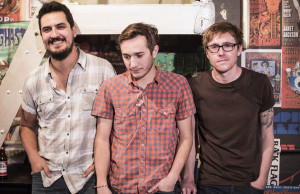LAFF Interview: ‘Sin Alas’ Director Ben Chace

Director Ben Chace‘s new movie “Sin Alas,” isn’t just a film with a dreamy look into an aging writer’s past, it is also the first American-directed film shot in Cuba since the revolution, making the story behind the production just as intriguing as the movie itself.
The film starts off with 70-year-old author, Luis Vargas as he discovers the woman he had a brief affair with as a young adult, has passed away. That night he can’t sleep and is tormented by pieces of a song from his lover’s famous dance performance in 1967. Luis is unable to forget the song and soon sets off on a mission to complete the melody as a way of letting go, but is led even deeper into a world of memory he has spent decades trying to forget.
Chace uses Luis’ predicament as a way to send audiences through different periods in Cuba’s history and it is a visual treat. We sat down with the director to discuss the film and what it was like filming in Cuba.
Tell me a little about the inspiration for the film; the thought process behind it.
Well, I really wanted to shoot something in Cuba, but I didn’t know how I was going to do that as an American. As an outsider, what story could I tell and make it real and make it meaningful? I had been down there a couple times before with my friend who is Cuban-American who was like on a roots discovery mission, and I always loved Cuban music and was just fascinated, I wanted to check it out. We ended up filming a little, very homemade documentary that was just me and a camera kind of visiting the places his father grew up. I fell in love with the culture and the country and I was thinking about how to capture it, and I went back to New York and spent a few years making other movies, but I was always thinking like ‘Ok I want to get back to Cuba and shoot something’ still wondering how to do it. And then I was reading Jorge Luis Borges, he’s a short story writer. All of his short stories fit in one book, from his whole career, and I always just go back to it and I was reading it again one day and I read the story of “El Zahir” which is about an old man. In that one he becomes fixated on this image of a coin, but it starts off when he goes to a woman’s funeral that he was in love with many years ago. So it’s about the idea of something being unforgettable and its also this kind of like labyrinth, a psychological labyrinth. I thought that was a great starting point to try to build a story in Cuba because Cuba’s all about memory and the past is always present when you’re there. It’s unavoidable because things haven’t changed, and you’ve got the reminder that you’re living in the revolution, like it’s always there, it’s inescapable.
I really liked the stylistic choices that separate the time periods, with the 60s shot in a hazy light and the 40s in black and white. When you were choosing to make them so clearly different was there a thought behind which era was going to look which way?
Yeah, well, there was definitely planning. We wanted to make the 60s stuff look like… I was trying to recreate in a way or illustrate the way memory works. And kind of how in some ways you stylize your own memories, you make things more grandiose. This affair that he had, he thinks of it like a Hollywood movie and he was like this young telenovela star in a tuxedo and that’s how he thinks of himself, in his heyday you know? And now he’s this kind of washed up old man trudging around in this gritty environment, but we wanted to really polarize that and add contrast to that because it also illustrates the difference of now and then in Cuba. So we shot it all on the same film stock, but we always knew that we would treat it differently. We shot the 60s stuff all on tripods and dollies, its smooth and we’ve got the fake rain machine behind it and we did all this lighting and stuff to try to make it look like a 60s Hollywood film as much as we could with this low budget –and the current day stuff it was mostly just natural light handheld in real locations. We did set dressing, but the sets are as naturalistic as possible, and we wanted it to have the rough and tumble feel of central Havana. Then in post-production we were able to push it a little farther, I actually found looks from those bold eras and we just emulated them. The look of the 60s is actually something called Magenta Fade, which is what 16mm which was shot in that year looks like now if it hasn’t been preserved. The greens disappear so all of a sudden things become kind of red and blue, I found some old footage from like the Soviet Era, I don’t know where it’s from but it was Eastern European stuff and when you see it you know.
So you shot it on location in Havana?
Yeah, in Havana and Hershey.
What was that like?
It was incredible, it was really amazing.
Was it difficult to get everybody out there or did you use all Cuban actors?
Yeah, yeah, everyone was Cuban, the only Americans were myself, my producer, and the cinematographer. So the crew and the cast were all Cuban. But you know you run into different things. It’s hard to move people around, move anything around. Cuba functions completely differently to America, but it’s a challenge to make any low-budget film, it was just a different set of challenges.
Do you speak Spanish?
Yeah, I mean pretty well. Well enough to get myself there, make it happen and get back.
I always wonder what it’s like to direct someone when you don’t speak the language the film is in.
I don’t know how that works exactly, but you know what I’ve learned just talking to other directors and making move movies, the key to direction is to do as little as possible. Just get the right people there and you know, make them like the script and cast the right people and they do their thing, you know. My one direction I gave usually, because one of the challenges as a director was to try to make a movie that could play to an American audience using Latin actors, and these actors are used to working mostly on stage and in telenovelas, so it’s a much more melodramatic thing that they do, that the kind of non-Latin audience, you know they don’t get that. So all I was doing was telling them to just bring it down a little, but, because you know they want to throw fireworks into every single line they deliver in a way so I was just like, bring it but a little less.
I also really liked the way the revolution is constantly present in the film without being touched on too explicitly, I was wondering if you had more to say about that, like how the revolution affects daily life in Cuba.
Well, it’s just, that’s the system that you have to contend with. And its unusual from our perspective, you know it’s hard to understand when you first get there because, I don’t know, it’s unique. It’s unique even to other parts of Latin America. I’ve traveled around Latin America pretty well and I don’t know it’s hard to describe really. It’s really hard to paint the full picture of it because it’s a holistic world that they inhabit and have to deal with and it manifests in the most grand philosophical terms and also in the most mundane daily stuff and it touches everything.
And I think American audiences especially don’t know very much about Cuba.
That’s the strange thing, and no one gets it. No one knows what the hell’s going on down there. I wanted to just show what people were going through and hopefully show that there’s just a lot of culture and humanity and great stuff there that in a way is suffering because of our ignorance of the situation. You know if we knew how fucked up it was down there we’d try to do something to change it but no one understands that we’re just given propaganda on all sides. We’re given this very thin and shallow idea of what is going on in Cuba you know? It’s like some woman dancing, Fidel, and what else do we know about it? A couple old cars. No one really knows what the daily struggle down there is like for people and my film I think touches on it, I think I did an okay job with this one character, but it goes deeper than that. You kind of have to go, and even if you go you have to spend a lot of time to get to the truth of it because people won’t say things out loud, there’s so much implicit stuff and there’s so much that you can say out loud and stuff you just have to witness. To me, it’s a labyrinth that’s why when I was like Borges, I was like what can I do to describe this, I need like a labyrinth blueprint to like tape images to and collect this thing and hopefully it will come close to representing something about the reality of that place.
Do you have any upcoming projects?
Well, I’m a musician, so I continue writing a lot of music and I’m trying to develop a documentary show that follows the development of rhythms over history. There’s just a lot of fascinating history and you get into it in Cuba. The guy who I’m hoping to work with, the composer, who did my scores, is this great Afro-Cuban guy from New York. There’s just all this great history of boats traveling from Africa to Haiti and from Haiti to Cuba, to New Orleans then to Chicago and New York and back down to Jamaica. If you learn about it you can actually hear how these beats slowly shift. I’m trying to develop a show that follows these musical currents.
Sin Alas premiered at the LA Film Festival June 11, 2o15




